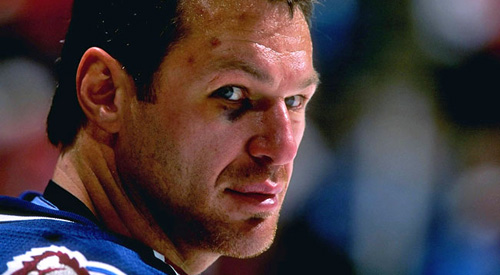
Claude Lemieux; hockey connoisseur
After an on-ice career seemingly defined by a small stack of controversial moments, Claude Lemieux certainly feels content with the mark he made on the game of hockey.
“I have no regrets about how I played the game,” he told The Good Point recently. “We always say rules are made to be broken.”
And, it turns out, he’s back for more.
Although the 46-year-old’s latest hockey-related endeavour will not break any rules per say, it hopes to break new ground in the skate-making industry.
Wedged in between family time and presiding over 4sports and Entertainment‘s North American division is an initiative with hockey skates brand Graf Canada that Lemieux himself notes may put a stop to an “epidemic” one day.
“Basically, we have teamed up with Brock University (in St. Catharines, Ontario) and we’ve gotten a grant from the (federal) government to support research in testing not just (Graf) products but different skates in general,” he said.
“Everyone has been sold on the ‘lighter is better, faster,’ but we’re working on a study that’s going to prove that’s not the case.”
The four-time Stanley Cup champion assures the study has an in-depth and all-encompassing purpose.
[php snippet=1]
“It’s being done so we can hopefully build a better skate that would prevent this epidemic of bone spurs and lace bites that we’re seeing in very young players, which is very scary,” Lemieux said.
A bone spur, according to Web MD, is the growth of extra bone in one’s feet, shoulders, hips, hands, spine or knees. A lace bite, on the other hand, is defined by Wiki How as “sharp pain or pressure along the extensor hallucis tendon, which runs from the front of the lower leg to the base of the big toe.”
An active coach for his son’s Minor Midget Toronto Red Wings squad, Lemieux still comes across bone spurs and lace bites on a regular basis.
“We used to see some of this in older players — guys who have been playing for 15 years — but now we’re seeing these terrible bone spurs in young players who are in their 20s,” he added. “There’s obviously a big problem in the way skates are constructed.”
Throughout the testing, three different age groups and skill levels will be monitored in order to provide ample evidence that these problems do indeed exist across the hockey community.
“I’ve seen it all over, with guys I played with even — going way back, Peter Forsberg had it,” Lemieux said.
Forsberg and Lemieux captured the Stanley Cup together in 1995-96 as members of the Colorado Avalanche. Over a span of twenty-plus years of NHL competition, the Buckingham, Quebec native made more than a lifetime’s worth of memories as a player.
The Quebec Major Junior Hockey League Hall of Fame member said hoisting his first Stanley Cup back in 1985-86 with the Montreal Canadiens resonates most with him in 2011.
“The first one obviously sticks out the most,” said the Verdun Junior Canadiens alumnus. “Such a young player, I was fortunate to win.”
In said playoffs, the rookie contributed 16 points in just 20 playoff contests. Over his career, a cool 158 points in 234 post-season games ranks him among the best ever to play spring hockey.
With almost a full hand of championship rings — and international medals to boot — the pesky winger’s impact exceeded any point totals he amassed.
“I lived for the playoffs,” said the 1995 Conn Smythe recipient. “That was the time of year to rise to the occasion.”
While scorned by some for the occasional dirty act, in whatever way he could, Lemieux undoubtedly rose to the occasion through a persistently competitive nature.
On Wednesday, September 7, Lemieux — along with the rest of the hockey world — took his game face off in lieu of the fatal Kontinental Hockey League’s Lokomotiv Yaroslavl team plane crash.
“I played against some of these guys and got to know Brad McCrimmon a little bit throughout the years. It’s just devastating,” said Lemieux, mere hours after hearing the horrific news.
“I have heard from players who have been playing in Russia in the last few years and they think the travel was difficult, the airplanes they were using were quite scary,” he added.
Currently intrigued and invested in the equipment component of the hockey industry, Lemieux knows just as well as anyone that safety is a major issue through various channels.
“It’s just really unfortunate,” he said of the KHL tragedy.
A man who managed to stay in the spotlight following his on-ice career via television appearances and owning a minor league franchise, Lemieux is comfortable laying low with a busy, hockey-filled — yet less publicized — schedule at the moment. At the same time, he doesn’t want to close any doors that may open down the road for him.
“I never say never,” he admitted, “but I am very happy with what I am doing now and I want to focus on this, but if the opportunity came about down the road who knows.”
[php snippet=1]

